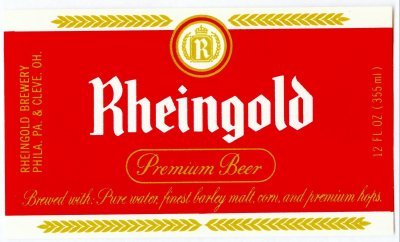HISTORY
In what American election is the greatest number of votes cast? The answer is, of course, the Presidential election. In what American election is the next-greatest number of voters cast? The answer is the annual Miss Rheingold contest. In 1956, the vote totaled just over 23 million, this year it promises to be even bigger.
—The New Yorker, September 21, 1957
During the heyday of the contest — from 1941 to 1964, the election of a new Miss Rheingold was an exciting, anticipated event. The pictures of six young women were displayed everywhere Rheingold beer was sold — in Pennsylvania, New Jersey, New York, Connecticut, Rhode Island, Massachusetts, Vermont, New Hampshire and Maine. In bars, in delicatessens and grocery stores, spread over billboards throughout New York and New England, the contestants smiled at bar hounds, shoppers, foreigners and citizens, adults and children.
Everyone had an opinion about which contestant should win. And everyone voted – as many times as they wanted to vote – for their pick among the smiling, demure, girl-next-door, all of them white, beauties.
It went on for twenty-five years, from the presidency of Franklin Delano Roosevelt to John Fitzgerald Kennedy – and it never lost its popularity.
Designed to sell Rheingold Beer, it did that and much more. It became an annual event with everyone voting for their favorite.
It was a simple contest. Celebrity judges – actors, columnists, and “Mad Men” – chose six finalists from among hundreds of hopefuls. The lucky six would compete for the title of Miss Rheingold in a six-week campaign.
At the height of the campaign there were 35,000 boxes displayed at the end of aisles, atop crates of Rheingold beer and on bar tops – always with pictures of the six finalists framing the box.
So many votes were cast that the bags of ballots were weighed instead of counted.
The contest was the creation of Philip Liebmann, a member of the family that had owned the Rheingold Brewery in Bushwick since 1855. It wasn’t the biggest brewery in Brooklyn, nor the most successful – until Liebmann chose startlet Jinx Falkenberg as the first Miss Rheingold for 1940.
After that, Liebmann turned the choice of Miss Rheingold into a public election – and it took off. The heavily financed campaign brought attention and participation. It was everywhere. Not just in bars and grocery stores, but in enormous billboards in every city neighborhood, suburb and country village. The finalists were announced every year in elaborately produced television commercials with the popular dance team of Marge and Gower Champion.
Miss Rheingold was the perfect girl next door. “A friendly, warm, nice girl,” according to celebrity judge Tony Randall. “Clean-cut All-American,” according to Emily Banks, Miss Rheingold 1960. “Clean, lovely graceful.”
But more than that, she represented an ideal of beauty in that era. There were never any Asians, Hispanics, Jews or African Americans. If anyone noticed the blatant exclusions, they didn’t mention it – or complain about it.
People all over New York and New England voted for this perfect “girl-next-door” – even if she was far from the girl who lived next door to them, even if she was portrayed in scenes that never had anything to do with their lives.
The newly crowned Miss Rheingold was seen every month in hundreds of advertisements, each of them reflecting the season. Miss Rheingold gardening in the spring. Miss Rheingold at a summertime picnic. Miss Rheingold hunting in the fall. Miss Rheingold carrying Christmas presents in the winter snow.
At its peak, the campaign cost $8 million a year – the equivalent of $60 million today. After the contest began, Rheingold tripled the sales of their beer. But that was just the beginning of Philip Liebmann’s achievement.
The Miss Rheingold contest was so appealing to so many people that it became part of popular culture. The auditions were major events covered in local newspapers. There were Miss Rheingold cartoons in the New Yorker magazine. The finalists were interviewed on radio, on television programs such as Jack Paar and Ed Sullivan — and radio programs like Joe Franklin and Arthur Godfrey. The contest was so much a part of its time that it was used in feature films as an instant indication of the 1950s and 1960s.
It all ended in 1964. An attempt to widen the market to the West Coast had failed. Sales of Rheingold beer had peaked and were falling off. Competition from other brands and labor costs squeezed out the lavish budget for the contest on the Rheingold Brewery balance sheets.
But there was another factor that spelled the end of the contest. By the mid-1960s, no business could advertise its brand with just demure, smiling white women on the verge of marriage. Women were demanding a more realistic image, one that included independent women with careers. Ethnic groups were demanding recognition of their place in the diverse population of the nation.
The contest ended – to live on in popular nostalgia for a way of life that had ended and would never return.
1940 JINX FALKENBERG
1941 RUTH OWNBEY
1942 NANCY DRAKE
1943 SONIA GOVER
1944 JANE HOUSE
1945 PAT BOYD
1946 RITA DAIGLE
1947 MICHAELE FALLON
1948 PAT QUINLAN
1949 PAT McELROY
1950 PAT BURRAGE
1951 ELISE GAMMON
1952 ANNE HOGAN
1953 MARY AUSTIN
1954 ADRIENNE GARRETT
1955 NANCY WOODRUFF
1956 HILLIE MERRITT
1957 MARGIE McNALLY
1958 MADELYN DARROW
1959 ROBBIN BAIN
1960 EMILY BANKS
1961 JANET MICK
1962 KATHY KERSH
1963 LORETTA RISSELL
1964 CELESTE YARNALL





